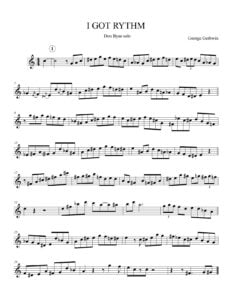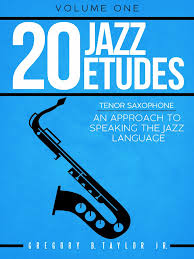Come join us now, and enjoy playing your beloved music and browse through great scores of every level and styles!
Can’t find the songbook you’re looking for? Please, email us at: sheetmusiclibrarypdf@gmail.com We’d like to help you!
Table of Contents
Remembering Don Byas, born on this day in 1912

Don Byas – I Got Rhythm (Gershwin)
Best Sheet Music download from our Library.

Please, subscribe to our Library.
If you are already a subscriber, please, check our NEW SCORES’ page every month for new sheet music. THANK YOU!
Don Byas: The Missing Link in Tenor Saxophone History

Born on October 21, 1912, in Muskogee, Oklahoma, Carlos Wesley “Don” Byas is one of the most crucial, yet sometimes overlooked, figures in the evolution of jazz saxophone. He stands as a direct and masterful link between the robust, Coleman Hawkins-inspired swing era and the harmonic daring of the bebop revolution. A musician of immense technical prowess and profound emotional depth, Byas carved a unique path that led him to become a revered jazz expatriate in Europe.
Biography: From Oklahoma to the World Stage
Byas’s musical upbringing was thorough. He studied violin, clarinet, and alto saxophone before settling on the tenor as his primary voice. He was a skilled musician from the start, even touring with territory bands. His big break came when he moved to New York City in the late 1930s, where he quickly established himself as a powerhouse soloist.
He replaced the legendary Lester Young in the Count Basie Orchestra in 1941, a testament to his already formidable reputation. It was during the fertile ground of the early 1940s New York jazz scene that Byas became a central figure. He was a regular at the famed Minton’s Playhouse, the incubator of bebop, playing alongside innovators like Dizzy Gillespie, Thelonious Monk, and Charlie Parker.
In a pivotal career move, Byas joined the Dizzy Gillespie Big Band for a tour of Europe in 1946. When the tour ended, he decided to stay, initially in Paris. He would never live in the United States again. This self-imposed exile, while diminishing his stateside fame, allowed him to become a living legend in Europe. He was celebrated as a king of jazz, free from the racial and commercial pressures of America, and he performed and recorded prolifically until his death in Amsterdam in 1972.
Musical Style: The Bridge Between Two Eras
Don Byas’s style is a magnificent synthesis of swing’s warmth and bebop’s agility.
- Tone and Sound: His most immediate identifying feature was his colossal, sumptuous sound. It was a rich, dark, and vibrato-laden tone, directly descended from Coleman Hawkins. It was a “big” sound, full of authority and romance, capable of immense power and tender delicacy.
- Phrasing and Technique: While his sound was rooted in the swing era, his phrasing was remarkably modern. He possessed a flawless technique that allowed him to execute the rapid, flowing, eighth-note lines that characterized bebop with ease. Unlike some of his swing-era peers, he could navigate the complex chord changes of tunes like “Anthropology” and “Donna Lee” without a hint of strain.
- The Balladeer: Byas was one of the greatest ballad interpreters in jazz history. His renditions of standards like “Laura,” “Body and Soul,” and “Stardust” are masterclasses in melodic embellishment and emotional storytelling. He would deconstruct a melody and rebuild it with breathtaking harmonic and rhythmic variation, all while maintaining the song’s essential sentiment.
In essence, he played with the harmonic sophistication and rhythmic freedom of the boppers, but delivered it with the opulent, romantic sound of the previous generation.
Harmony and Improvisational Approach
Byas was a master harmonist. His time at Minton’s exposed him to the new, extended chords that were becoming the foundation of bebop. He absorbed this language completely.
- Chordal Improvisation: His solos are a textbook of chord-based improvisation. He didn’t just play scales; he arpeggiated complex chords (9ths, 11ths, 13ths) with fluency, outlining the harmony with stunning clarity.
- Reharmonization: Even on standard tunes, he would imply substitute chords and passing harmonies, creating a constantly shifting and sophisticated harmonic landscape beneath his melodic lines. His famous 1945 recording of “Laura” is a prime example, where he transforms the popular movie theme into a profound harmonic exploration.
- Logical Development: His solos were not just strings of licks; they were thoughtfully constructed narratives. He would develop motifs, building solos with a sense of architectural logic and dramatic climax.
Compositions

Browse in the Library:
Or browse in the categories menus & download the Library Catalog PDF:
While primarily revered as an interpreter, Byas was also a skilled composer. His most famous original is undoubtedly the blues line “Donna Lee.” Ironically, the tune became a bebop anthem most associated with Charlie Parker, but it was Byas who first introduced it. Other notable compositions include the swinging “Free and Easy” and “Byas-a-Drink,” which showcase his knack for crafting memorable, blues-drenched melodies perfect for improvisation.
Key Collaborations
Byas’s career placed him alongside a who’s-who of jazz giants across different eras:
- The Swing Masters: He played and recorded with Count Basie, Lucky Millinder, and Andy Kirk, honing his craft in the big band format.
- The Bebop Pioneers: His work at Minton’s and his recordings with Dizzy Gillespie (“Salt Peanuts,” “52nd Street Theme”) and Max Roach are seminal documents of the birth of bebop. His 1944 session with bassist Oscar Pettiford is another classic of the era.
- The European Years: In Europe, he collaborated with visiting American stars like Dizzy Gillespie, Art Blakey, and Bud Powell, and became a central figure in the continental jazz scene, recording with European musicians and other expatriates like Dexter Gordon.
Legacy and Influence
Don Byas’s legacy is that of a complete saxophonist. He embodied the entire history of the instrument up to his time. He directly influenced a generation of players who followed, including Sonny Rollins, who cited Byas’s powerful sound and harmonic command as a major early inspiration, and Dexter Gordon, who saw in Byas a model for how to blend swing-era warmth with modern ideas.
His decision to live in Europe, while perhaps costing him a level of stateside fame commensurate with his talent, ensured his artistic freedom and preserved his majestic style in a pure form. He never chased trends; he was the trend. To listen to Don Byas is to hear the very moment jazz tenor saxophone evolved, played by a man who mastered both its past and its future. He remains, for the discerning listener, one of the most commanding and satisfying voices in the history of the music.
You Go To My Head – Don Byas
Browse in the Library:
Or browse in the categories menus & download the Library Catalog PDF:
